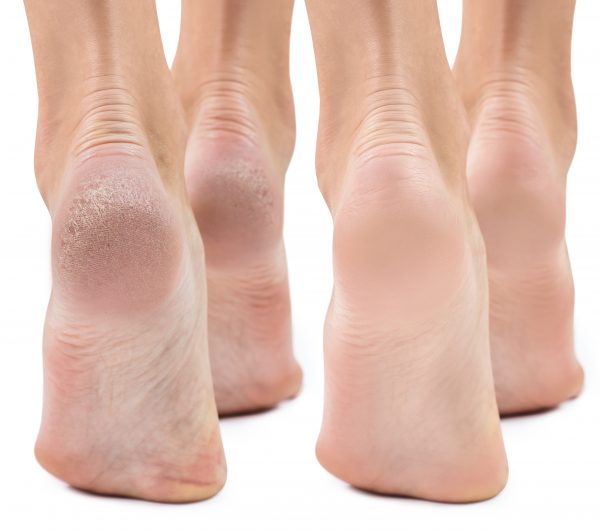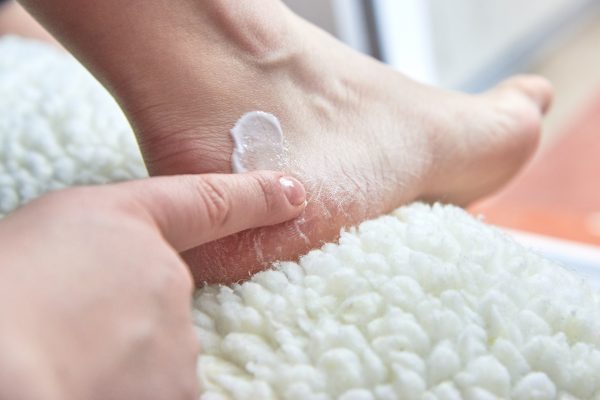When you take off your socks, are your feet a cracked nightmare? That gnarly, flakey skin not only itches, but as it worsens, dry feet can also really hurt. Deep cracks can cause soreness, redness and swelling, and more— especially when standing or moving.
Take a small bit of comfort in knowing that you’re not alone. The most recent survey from the National Foot Health Assessment found that 20% of American adults ages 21+ have experienced cracked skin on their feet. While these results date back to 2012, this is still likely a more common issue than many imagine.
In this post, we’re here to help you figure out why your feet are dry by looking at common causes of both Xerosis, AKA dry skin anywhere on your body, as well as certain foot infections and conditions.
We’ll also offer some easy home treatment options to see if you can beat the cracking without professional help!

Symptoms of Dry Feet
While many symptoms of dry feet are common indicators of generalized skin dryness anywhere on your body, others aren’t so obvious.
- Dry or scaling skin that’s often rough to the touch
- Fine lines or cracks on the bottom of the feet and toes
- Prominent cracking/fissures on the heel, sometimes deep ones that bleed
- Redness and swelling
- Skin peeling or flaking
- Itching
- Tightness, especially when exposed to water
Keep in mind that your reaction will often vary based on the root cause of the dryness and its severity, which we’ll explore below…
Causes & Risk Factors of Dry Feet
Xerosis, AKA dry skin, is caused by two major factors: a deficiency in the skin barrier lipids or a deficiency of Natural Moisturizing Factors (NMF)— both of which Eucerin does an excellent job explaining.
Oftentimes these deficiencies are a direct result of internal influences and/or external factors, but commonly foot dryness, in particular, is associated with infection:
Internal Influences
- Age (wherein your skin naturally loses resilience)
- Dehydration
- Diet, specifically one that’s lacking important skin-friendly vitamins
- Medications that influence your skin’s health or overall immune system
- Diseases that influence your skin’s health or overall immune system like diabetes or hyperhidrosis
- Pre-existing skin conditions like eczema or psoriasis
- Pre-existing foot conditions like flat feet
Additionally, obesity can exasperate dry feet, with excessive weight pressing down on your pads and causing deeper cracking.
External Influences
- Environmentally dehydrating conditions like swimming in highly chlorinated pools or getting too much sun
- Heat from hot showers, spending too much time in warm areas or by a fireplace, etc.
- Inappropriate cleansing like washing skin too often or with body wash, shampoo, conditioner, etc. that strips your foot skin of natural lipids
- Low humidity, varying by region and season
- Open-back shoes, “which allow the fat pads in the heel to expand sideways and increase pressure on the skin, causing it to crack,” according to IPFH.
Infections
- Fungi that penetrates your skin’s foot barrier and causes conditions like Athlete’s foot
- Bacteria like erythrasma that does the same
These foot infections are often picked up from walking barefoot, getting an unsanitary pedicure, showering in gyms, etc.

Home Treatments for Dry or Cracked Feet & Heels
Oftentimes, Xerosis (dry skin) on your feet can be treated at home with proper attention and care.
In our How to Permanently Heal Cracked Feet post, we outline some great DIY advice around:
- Keeping your feet clean to prevent infection or worsening of symptoms
- Soaking and exfoliating to remove excess dry skin
- Sealing deep cracks to allow them the right conditions to heal
- Finding the right moisturizer to keep your feet hydrated and happy moving forward
However, oftentimes external and internal influences or infections need to be addressed to prevent a recurrence of dry feet flakiness and pain.
That’s where a podiatrist comes into play— counseling you on important adjustments to your everyday routine, ways to live with a pre-existing condition to prevent dry skin, and treatment for pesky fungal or bacterial foot infections.
Professional Treatments for Cracked Feet & Heels
Only a trained podiatrist can give you a true diagnosis as to whether you’re suffering from Xerosis and what internal or external factors may be the cause, such as a foot infection.
A foot specialist can also help safely and near-painlessly treat dry feet by:
- Removing dead skin
- Prescribing a softening removal agent in order for you to remove dead skin yourself
- Properly sealing deep foot cracks
- Dressing or bandaging an infected area
- Prescribing antibiotics for a specially-diagnosed foot infection
- Recommending best practices for preventing dry feet moving forward
The Final Diagnosis & Proper Care You Need
It’s not always easy to tell if your feet are just naturally dry or if you are suffering from another issue. A prime example of this is foot peeling, which could be both a symptom of dry skin conditions like eczema and the result of excessive moisture from a condition like hyperhidrosis. Confusing, right?
Here at Foot & Ankle Group, our skilled podiatrists can get to the bottom of your dry feet cause and offer the treatment options you need for quick relief.
Give us a call to set up an appointment at 239.936.5400, today.
Categorized in: Blog
Comments are closed